Is apartment living better for the environment?
Apartment developments are booming in the CBD, and as the City of Adelaide strives to hit 50,000 residents by 2040, InDaily looks at whether a move into a CBD apartment is a good move for the environment.

Apartment blocks in the CBD. Photo: Nat Rogers/InDaily
With the Monument apartment development recently announced, and several residential developments already underway, it seems Adelaide might soon transition from its place as a City of Churches to a City of Apartments.
It is the aim of the City of Adelaide to reach 50,000 residents by 2040, and so to complement the increasing number of city dwellings, the City of Adelaide and State Government are offering assistance packages and concessions for people making the move into off-the-plan apartments.
These include a $10,000 pre-construction grant for off-the-plan apartments in buildings yet to be built, a stamp duty concession of up to $15,500, and a scheme that will offer a five-year rate-free period for owner-occupiers who purchased off-the-plan dwellings.
In addition to the financial benefits, there are a great many more benefits for people moving into the city to enjoy, says Lord Mayor Martin Haese.
“City living offers great lifestyle, social, economic and environmental benefits. Many people who live in city apartments choose more sustainable methods of transport such as walking, cycling and/or public transport,” he says.
“Apartment living can reduce traffic congestion as people who live in the city also tend to work and socialise in the city. Apartments in locations near transport, work and amenity hubs also saves time, money and reduces traffic congestion as residents are conveniently located close to the shops or cafes and facilities they need, thereby reducing use of a car for short trips.”
Adelaide’s burgeoning apartment developments also contribute to the Council and Stage Government’s joint Carbon Neutral Adelaide action plan by ensuring “new apartment developments meet environmental best practice standards.”
“Any development applications for new apartments in the city are assessed against council-wide energy efficiency principles and objectives of the Development Plan which seek development to be compatible with the long-term sustainability of the environment, minimise consumption of non-renewable resources, and utilise alternative energy generation systems,” Haese says.
When looking at whether apartments are better for the environment than detached houses, the difference comes down to good design.
“The old designs are locked into old, inefficient ways of building, but the newer ones will have to comply with the newer design and best practice to sell well, and as a result… there are much more sustainable design principles involved,” CEO of the Low Carbon Living CRC, Deo Prasad, says.
“With an apartment, you have a lot of what they call adiabatic walls and floors, so between apartments and walls and floors and ceilings, they’re connected, and more often than not, you have one or two faces, if you like, facing outside, and you can deal with that much better, in terms of heat gain/heat loss.
“There have been studies done that look at how people use energy in houses and apartments. If you just look at within the apartment, energy use is better than standalone house, but normally an apartment comes with a lot of common areas that are relatively uncontrolled.
“The potential for being much more energy efficient is better in apartments, if the surrounding energy use and all of that is better managed and you can use renewable energy for public areas, common areas.”
More than just being environmentally beneficial, apartment living offers a “triple bottom line” advantage, Prasad says.
“The social, economic and environmental parameters all kick in; Socially more people interacting with each other and so forth; from a business point of view, you can have service sector businesses surviving much better if there’s a higher population density… More people will lead to more activity there, which is good for business, and if the apartments and things are much lower carbon, which the Carbon Neutral Adelaide goal is all about, then that will be a great outcome.”
Solstice Media has partnered with the South Australian Government to provide information about the transition to a low-carbon economy. Read more stories like this here.




